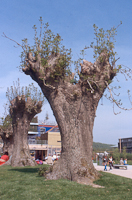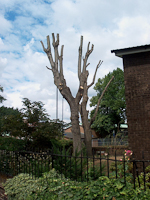 Early spring is a good time to prune many trees, but it is important
to do this properly. Topping -- cutting the crown off -- not only makes
a tree ugly, it can lead to its early death, says a Penn State
ornamental horticulture expert.
Early spring is a good time to prune many trees, but it is important
to do this properly. Topping -- cutting the crown off -- not only makes
a tree ugly, it can lead to its early death, says a Penn State
ornamental horticulture expert.
"Many home owners assume that if they top a large tree, it will
compensate by producing a new, healthy, lower-growing crown," says
J. Robert Nuss, professor of ornamental horticulture in Penn State's
College of Agricultural Sciences. "It's not true. Removing the
central trunk and the tops of main branches permanently destroys a
tree's form and causes unnatural growth."
Topping severely weakens trees because it removes too many leaves.
Without enough leaves to photosynthesize, the tree slowly starves to
death. When trees are topped, they develop bristling "water
sprouts," or "suckers." "To the untrained eye, this
looks as though the tree is rejuvenating," says Nuss. "But
suckers don't develop into substantial limbs or produce enough leaves.
They remain weak and spindly, and snap off easily in storms."
 Sometimes topped trees develop a double leader, or trunk. This new
trunk often is weaker than the original and can be prone to splitting.
The massive root system also is weakened because it no longer receives
adequate nourishment from the crown. Trees in this condition are more
likely to split or blow over in a storm.
Sometimes topped trees develop a double leader, or trunk. This new
trunk often is weaker than the original and can be prone to splitting.
The massive root system also is weakened because it no longer receives
adequate nourishment from the crown. Trees in this condition are more
likely to split or blow over in a storm.
"If you plan to top a tree in your yard because you fear it
might blow over on your house, consider this: a mature tree with a
healthy root system is much less likely to blow over than a weak one
with damaged roots," says Nuss.
Topping a tree also creates large wounds where the crown and limbs
are cut off. It takes years for these stubs to heal. In the meantime,
they provide the perfect environment for harmful insects, disease and
decay.
"Before you prune a tree, think about what you want to
accomplish," says Nuss. "It's also important to learn about
the tree's natural form, growth habit, growth rate, height and spread.
"Pruning is meant to remove dead, diseased, damaged or
insect-infested branches and keep the rest of the tree healthy. It's
also used to allow more air and light to reach the center of a
tree."
On trees more than 20 feet tall, it's wise to hire a professional
tree service. "If you're inexperienced and attempt to prune a large
tree, you could injure yourself as well as the tree," says Nuss.
"Tree services have the knowledge and equipment to do this job
effectively and safely."
Utility companies often are forced to top trees growing under
wires--the only alternative is to cut the trees down. "If you have
utility wires crossing your property, it's best not to plant trees under
them," says Nuss. "If you want to plant trees under wires,
plant low-growing ones, such as dogwoods or redbuds."



